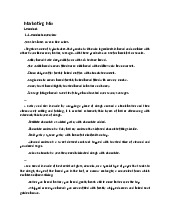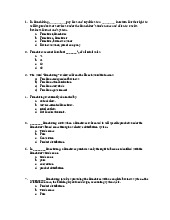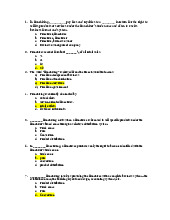




Preview text:
1. In franchising, _________ pay fees and royalties to a ________ in return for the right to
sell its products or services under the franchiser’s trade name and often to use its business format and system. a. Franchiser, franchisee b. Franchisee, franchiser c. Franchise, business owner
d. Business owner, parent company
2. Franchises account for about _______% of all retail sales. a. 74 b. 34 c. 63 d. 50
3. The word “franchising” is derived from the French word that means:
a) Free from independent business b) Free from standardization c) Free from servitude d) Free from government
4. Franchising is currently dominated by: a. auto dealers.
b. service-oriented franchises. c. retail outlets. d. fast food restaurants.
5. ________ franchising exists when a franchisee is licensed to sell specific products under the
franchisor's brand name through a selective distribution system. a. Trade name b. Pure c. Conversion d. Product distribution
6. In ________ franchising, a franchisee purchases only the right to become identified with the franchisor's trade name. a. trade name b. pure c. conversion d. product distribution
7. __________ franchising involves providing the franchisee with a complete business system--the
established name, the building layout and design, accounting systems, etc. a. Product distribution b. Trade name c. Pure d. Conversion
8. Most gasoline products are sold through the _________ system of franchising. a. product distribution b. trade name c. pure d. conversion
9. McDonald’s is an example of a _____ franchise. a. conversion b. trade name c. product distribution d. pure
10. Most new franchise outlets don’t break even for at least _______ months. a) Two to four b) Three to six c) Six to ten d) Six to eight
11. Before beginning operations, _______ franchisees take a 55 hour course and then spend an
additional 34 hours in on-the-job training. a) McDonald b) Radio Shack c) Subway d) Dunkin Donuts
12. The success of franchising is largely due to:
a. the economic growth of the United States and other developed nations, economies.
b. more college students choosing to go to work for themselves rather than for corporations.
c. the mutual benefits it provides to the franchisor and franchisee. d. all of these factors.
13. Nearly ____ of the International Franchise Association’s member indicate that they offer some
type of financial assistance to its franchises. a) Half b) Three-forth c) One-forth d) 90%
14. McDonald's worldwide success as a franchise can be attributed to a few simple strategies, including:
a. complete customization of the menu to fit local tastes.
b. Ability to obtain prime locations in high-traffic areas.
c. using U.S. managers and employees whenever possible.
d. standardizing processes and closely managing workers.
15. A significant advantage a franchisee has over the independent small business owner is
participation in the franchiser's___________.
a) centralized and large-volume buying power b) social gatherings c) profits d) policies
16. The typical franchise company averages sales of less than ____ outlets in the first year. a. three b. seven c. ten d. one
17. In view of the cause of most new business failures, probably the most valuable service provided
franchisees by the franchisor is:
a. management training and experience. b. national advertising. c. financial assistance. d. territorial protection.
18. The franchising boom spearheaded by _____ in the late 1950s brought with it many prime
investment opportunities. a) Dunkin Donuts b) McDonalds c) Burger King d) Subway
19. In franchising, the reputation of the franchisor is dependent on:
a. their locations and popularity with the local customer.
b. the brand name recognition and appeal.
c. the rate of growth and the number of national outlets.
d. the quality of the goods and services provided.
20. Franchise advertising programs:
a. are organized by the franchisor but controlled locally by the franchisee.
b. are an expense borne by the franchisor.
c. require franchisees to spend a minimum amount on local advertising.
d. allow voluntary participation.
21. When it comes to financial assistance for franchisees, the franchisor often: a. provides direct financing.
b. assists in finding financing and occasionally provides direct assistance in a specific area.
c. waives royalty fees for franchisees not making an adequate profit.
d. generally does nothing, as finding financing is a requirement for qualifying for a franchise.
22. The primary advantage of buying a franchise over starting your own company is:
a. in the purchase of the franchisor's experience, expertise, and products.
b. the fact it is much less expensive than doing your own business start-up.
c. the extensive assistance offered in finding start-up capital.
d. the absolute territory protection offered by all franchisors.
23. Most franchise experts consider the most important factor in the success of a franchise to be: a. the simplicity of the idea. b. location. c. territorial protection. d. financing.
24. Territorial protection in franchising:
a. varies according to industry.
b. is basically every franchisee for him/herself.
c. is absolute and uniform across industries.
d. is no longer an issue for most franchisees.
25. The failure rate for franchises is:
a. higher than the rate for all new businesses.
b. no different from the rate for all new businesses.
c. lower than the rate for all new businesses.
d. indeterminable because of the Right to Privacy Act.
26. Approximately ____% of new businesses fail by the second year of operation, while ____% of
allfranchises fail in any given year. a. 2; 17 b. 12; 15 c. 14; 22 d. 24; 7
27. There are two main risks in purchasing a franchise. First, that of the franchisor's experience and business system, and second:
a. the brand name recognition of the franchise.
b. the entrepreneur’s managerial skills and motivation.
c. the franchisor’s financing.
d. the economy trends in the country at the time the franchisee begins operation.
28. The first, second and third growth wave in franchising respectively, are:
a) Low-cost franchises that focus on niche markets; shift to service sector; fast-food
restaurant using the concept of rapid growth
b) Fast-food restaurant using the concept of rapid growth; shift to service sector; low-cost
franchises that focus on niche markets
c) Low-cost franchises that focus on niche markets; fast-food restaurant using the
concept of rapid growth; shift to service sector
d) Shift to service sector; low-cost franchises that focus on niche markets; fast-food
restaurant using the concept of rapid growth
29. Despite all the benefits, there are a number of disadvantages to franchises, such as:
a. the time consumed by the management training and support the franchisor provides.
b. the cost of national advertising.
c. strict adherence to standardized operations. d. territory limitations.
30. The commerce department reports that the most expensive franchises in terms of total investment are: a. retail franchises.
b. business service franchises. c. McDonald’s franchises.
d. hotel and motel franchises.




